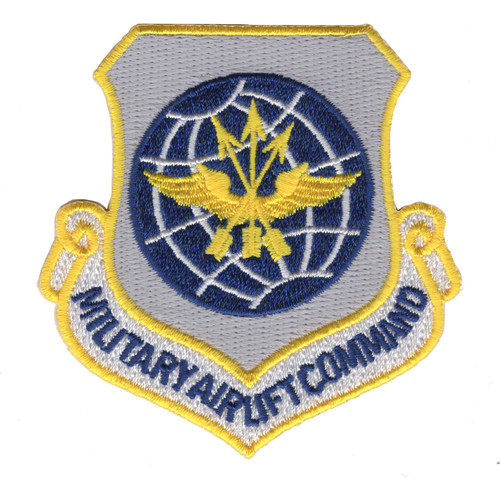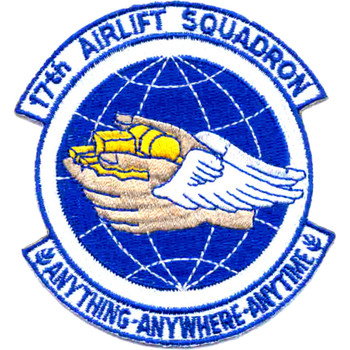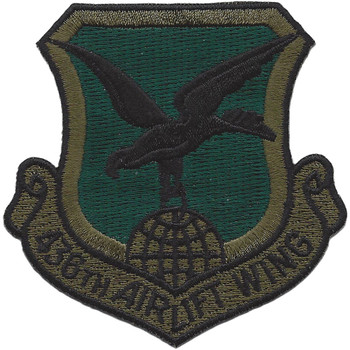Description
Military Airlift Command Patch (U.S. Air Force) 3.0" x 3.0" Embroidered Patch with Iron-On Backing
Superior Materials: Made with premium polyester thread and durable twill fabric, ensuring long-lasting color and strength.
Advanced Embroidery Technology: Crafted using the most advanced embroidery machinery, guaranteeing intricate detail, sharp lines, and consistent quality every time.
Easy Iron-On Application: Features a heat-activated adhesive backing for quick, no-sew attachment. Simply position, iron, and press for a secure bond.
Versatile Use: Perfect for personalizing jackets, backpacks, uniforms, or any fabric surface that needs a touch of personality.
Durable and Washable: Designed to withstand everyday wear and occasional washing without fading or fraying.
Formations & Origins
The Military Airlift Command (MAC) was established on January 1, 1966, as a result of the merging of the Military Air Transport Service (MATS) and the Air Force's airlift operations. The formation of MAC was part of a broader effort to centralize and streamline the United States Air Force’s airlift capabilities during the Cold War era. Its purpose was to provide rapid and global air transportation to move personnel, equipment, and supplies to any part of the world on short notice, which was crucial in maintaining the U.S. military's ability to respond to crises swiftly.
MAC was responsible for planning, executing, and overseeing the strategic and tactical airlift missions needed to support U.S. military operations, humanitarian aid, and even diplomatic efforts. The command's operations spanned across the globe, ranging from military deployments to transporting supplies in times of national or international disaster. For decades, MAC became the backbone of U.S. air mobility, ensuring that U.S. forces were able to deploy quickly and efficiently, regardless of location or time zone.
Notable Commanders
The leadership of MAC was key in establishing the operational prominence and global reach that the command came to hold. One of the most notable figures in the history of the Military Airlift Command was General William W. Momyer, who served as its first commander from 1966 to 1969. Under his leadership, the command was able to integrate the capabilities of both MATS and the Air Force, creating a unified command structure that was efficient and effective.
General Momyer and his successors worked tirelessly to modernize the airlift capabilities of the U.S. Air Force, overseeing the introduction of advanced aircraft and the development of strategic planning that would enable MAC to support operations in some of the most challenging environments. Additionally, the command’s leadership worked to ensure that the soldiers, airmen, and personnel within the airlift community had the training, experience, and resources necessary to carry out their vital missions, often under high-pressure and dangerous circumstances.
Major Campaigns/Operations
MAC’s operational history is filled with numerous significant campaigns, missions, and humanitarian efforts that highlighted its role as the United States’ air mobility backbone. One of the most famous and vital operations was the Berlin Airlift (1948-1949), conducted by the predecessor of MAC, the Military Air Transport Service. Although MAC was officially formed after the airlift, it is considered a precursor to the role MAC would later assume, and the mission demonstrated the importance of airlift operations in global conflict and diplomatic efforts.
The most notable operation during MAC's operational years came during the Vietnam War. MAC played a significant role in airlifting troops, supplies, and casualties to and from Southeast Asia. This included transporting U.S. forces into combat zones and evacuating them, along with providing critical supply lines that kept U.S. forces operating in the field.
Perhaps the most intense moment for MAC came during the 1990-1991 Gulf War (Operation Desert Storm), when its airlift capabilities were crucial in the rapid deployment of U.S. forces to the Middle East. The speed at which troops and equipment were mobilized demonstrated the power of strategic airlift operations and the critical importance of MAC in modern warfare.
Additionally, MAC played a key role in humanitarian airlift missions, such as those following natural disasters. From the earthquake in Haiti in 2010 to the relief efforts in the wake of typhoons and floods, MAC ensured that critical supplies reached the areas in need quickly and efficiently, showcasing its versatility and adaptability in both military and non-combat operations.
Specialized Role/Equipment
MAC’s specialized role was one that required not only highly trained personnel but also the most advanced equipment in the U.S. Air Force's arsenal. It was tasked with handling the most critical airlift missions, whether that meant rapid troop deployment, moving heavy equipment, or delivering aid to regions hit by disaster. The airlift command was equipped with an array of aircraft designed to perform a wide variety of roles.
Among the most iconic and effective planes operated by MAC was the C-130 Hercules, a versatile transport aircraft capable of carrying a wide range of cargo, including troops and vehicles. Its ability to operate from short and unimproved airstrips made it indispensable during conflict zones and humanitarian missions. The C-141 Starlifter and the larger C-5 Galaxy were also major workhorses for MAC, capable of carrying oversized and heavy cargo across long distances. The C-5, in particular, could carry massive loads, including tanks, military vehicles, and helicopters, making it essential for heavy-lift operations.
The KC-135 Stratotanker, used for refueling aircraft in mid-flight, also played a vital role in extending the range of airlift operations, enabling aircraft to reach farther destinations without the need for frequent land-based refueling stops.
These aircraft, combined with the highly skilled crews of airmen, loadmasters, and flight crews, allowed MAC to be ready for any mission, whether it required rapid deployment to a war zone or responding to a natural disaster halfway around the world.
Acts of Heroism
The Military Airlift Command’s personnel often faced challenging and high-risk situations, whether in wartime or during humanitarian operations. In conflict zones, airlift crews regularly flew dangerous missions into active combat zones, often under the threat of enemy fire, as they delivered troops and supplies or evacuated casualties. These crews displayed incredible bravery, flying into airfields under fire or in deteriorating weather conditions to ensure that the mission was accomplished.
One of the most notable examples of heroism came during the evacuation of Saigon at the end of the Vietnam War. During Operation Frequent Wind, MAC aircraft were instrumental in evacuating thousands of American personnel and Vietnamese civilians, often under harrowing conditions. The crews of these aircraft were exposed to significant danger as they flew in and out of a besieged Saigon, showcasing remarkable courage and dedication to their mission.
Legacy & Notable Achievements
The legacy of the Military Airlift Command is deeply rooted in its ability to quickly respond to both military and humanitarian needs. Throughout its existence, MAC demonstrated that air mobility is not just about moving people and equipment, but also about ensuring that global operations can continue regardless of geography, politics, or disaster.
MAC’s contributions during major conflicts, from the Vietnam War to the Gulf War, cemented its place as a key component of U.S. military operations. But its legacy is also seen in its contributions to peacekeeping and humanitarian aid missions. Whether it was delivering supplies during natural disasters or providing a lifeline to the war-weary, MAC’s versatility and readiness became essential to the success of countless operations.
The command was eventually replaced in 1992 by Air Mobility Command (AMC), but its impact continues to be felt. The modern AMC carries forward the mission of rapid global air mobility, further enhancing the ability of the U.S. military to respond to crises quickly and effectively. The history of the Military Airlift Command, therefore, is not just about past achievements; it continues to inspire the operations that shape the military’s airlift capacity today.
The Military Airlift Command Patch is a symbol of this legacy—representing the extraordinary airmen who carried out these critical missions with professionalism and courage. From combat operations to humanitarian relief, the men and women who wore this patch stood as the backbone of U.S. airlift capabilities. Their legacy is one of unwavering commitment to the global mission of rapid response and readiness.







